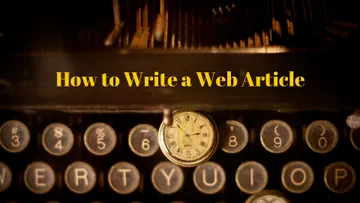How to Write a Web Article

Dave Schools, Former Digital Strategist
Article Category:
Posted on
Follow this simple and proven framework to organize your writing for effective delivery on the web.

When I first started writing on the web, I knew nothing. I was scared of the gavel-wielding, faceless, Redditesque crowd (whom I now love). But I found my first footing when I submitted an article to a niche blog I liked and followed (more below).
Since then, I’ve been able to write several top stories on Medium, including my best one: I sat down with a millionaire who operates 10 businesses while sailing around the world with his family, which has 7.2k recommends and has been picked up by several publications including Business Insider, The Observer, Quartz, et al.
I’m not trying to be boasty (intentional new word — trying it out), I’m just saying there is a structure that works for single-topic web articles. My hope is that it will help new writers take the leap as I did.
Credit for this structure goes to Crew and to Andrea Ayres Deets, who is an amazing writer and inspired me to write several years ago.
The first time I ever freelanced, I submitted an article to the Crew Blog and Andrea replied with the loose and simple formula they use for structuring their posts — one that I still use today and the one I am about to show you now.
Let it be known, there is no perfect formula for a successful blog post. It takes more than words and pictures — a lot of which is out of our control (i.e., network algorithms, timing, audience, etc.). But sometimes you need a good framework (the one below built up a 1 million+ visitors) to get started. I did. So here it is.

I. Intro
(Anecdote) Start with an experience from your own life. Write a story in the first person. Be vulnerable. My favorite writer, James Altucher, says to “Bleed in the first sentence.” This builds personal connection with your reader, even if you are representing a big brand. To me, this is where the good writers distinguish themselves from average writers; the best writers can tell a short, gripping, and humorous story in less than five sentences.
(Transition) After the opening anecdote, you need to transition to the thesis. Tie the personal story to the thesis by writing a sweeping statement with broad application.
(Thesis) Answer the reader’s question: why should I read this? You’ve cast your net widely with the transition, hoping to catch as many readers as possible, now laser in to a specific and compelling case. Make the time they spend reading your article a rewarding experience.
Your thesis should be damn similar to your title. The reader clicked the title because they thought it sounded interesting; if they leave the article after reading your thesis, then it means you mistitled your post (click-baiter!). The title-to-thesis relationship should be monozygotic.
II. Main argument 1
Lose yourself here. Now that the reader has agreed to listen, quote experts, cite research, and draw from history. Do not insert your own opinion here. Rely on the authority and experience of big names.
This needs to be a research-backed argument. Bring in science to support your claims. No one can argue with science.
[show chart or diagram graphic]
Also, its super helpful to give readers a 1–3 sentence description of the research you cite, just in case people don’t have the time to go to another link to read it themselves.
III. Main argument 2
Continue building momentum. Except this time use case studies from various sources. You’ve stated your point and given facts to back it up, now tell a story showing it worked for someone.
[show picture of person/people in story]
Once you’ve told the story, knit argument 1 and argument 2 together. Show how the scientific proof manifested in the story. This congruence creates a neural connection between the right and left brain of the reader, resulting in the foundation of a memory.
IV. Takeaways (3–5 depending on length)
- Use a bulleted or numerical list
- to give the user specific and
- actionable ways to implement the thesis
Remember, takeaways should be backed by examples and research for why these ways and methods are superior (or why these will get readers the results they desire).
V. Conclusion
Circle back to your beginning anecdote. Finish the story, or mention how you would do it differently now that you know the thesis. This has a satisfying “bookend” effect on the article.
Finally, zoom out to a bird’s eye view and show the macro-impact of the thesis. The goal is to leave the reader inspired.
So there it is. I hope that makes it easier for you to write your next web article. It helped me.
But can I be honest for a moment? I don't always use this format. And actually, I hope you don't always use this format. How boring would that be? Use it as a guide. As Pablo Picasso said:
"Learn the rules like a pro so that you can break them like an artist."